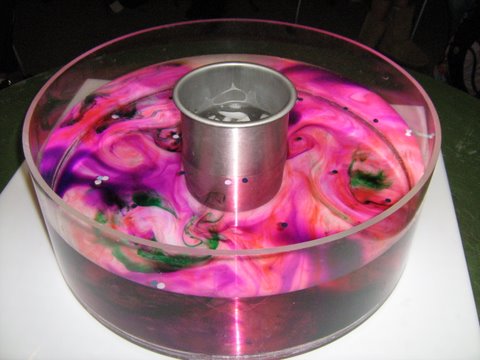PAOC Spotlights
Weather-in-a-Tank Lite - GFD for Middle School
Instead of rolling over and going back to sleep, Saturday mornings this Spring first year grad student Jareth Holt has been heading back in to MIT to teach middle schoolers a little bit of weather and a whole lot of fluid mechanics.
Holt's course, based on John Marshall's "Weather and Climate Laboratory" (12.307-lite, if you will) is run under the aegis of High School Studies Program (HSSP), a program intended to let students take an in-depth look at a variety of academic and non-academic subjects. In a recent interview I asked Jareth about the course he has been teaching:
HH: What is your course called?
JH: "Weather in a tank", a more common name for John Marshall's class and the official name of the associated NSF-sponsored educational outreach project. This includes his permission, as well as his help in figuring out the focus and outline of the course. (And, as the picture shows, access to the lab equipment for demonstrations).
HH: How many weeks is it? How long is each class?
JH: It's an 8-week program, 90 minutes each week with around 12-15 students in each class.
HH: Where do the students comes from and what kind of students are they?
JH: The course was aimed at middle school students who might be taking or have taken earth science topics in school. Only 6th-9th grade students were allowed to take the course. About half the students are home-schooled; the other half come from schools in relatively nearby towns like Wellesley and Winchester. These are ambitious students who come to MIT through this program to take non-standard classes, subjects that are outside most middle- and high-school curricula. HSSP isn't a program that provides grades or credits, so it really is about exploring a topic for the sake of the topic.
HH: Where are classes advertised?
JH: The classes are listed on the HSSP website (main site, current catalog). HSSP is a broad program, with fall, spring and summer sessions every year. A lot of students are repeat business, signing up for every session after they've learned about the program. HSSP is also advertised directly to schools, who then tell students and parents about it.
HH: How did you get involved in this?
JH: I had a roommate over summer, a Harvard student, who was teaching a class through this program. Later on, I saw an advertisement for it in the elevator of the Green Building, so I applied. I really wanted the teaching experience; I think teaching is incredibly important, and can get overlooked in academic science. There will be plenty of chances to TA courses, but planning and designing your own course is a fundamentally different skill set. I'm glad to have the opportunity, and I'd like to do it again.
HH: What are your goals with this class?
The goal of the class is to explore what components make the weather. The class is focused on building up a picture of the large-scale atmospheric circulation based on:
- The physics and chemistry of radiation, and the pole-equator temperature difference;
- The methods by which fluids transport heat to maintain that temperature difference (e.g. convection); and
- How the rotation of the earth changes these transport methods.
A secondary goal of the class is to learn a bit of functional meteorology: understanding when and why low-pressure systems might create clouds, using geostrophic balance to read a weather map, and seeing how synoptic-scale patterns are created by the jet stream. The unstated goal is to have fun looking at all the weird things that happen in our atmosphere every day, from watching videos of clouds and storms to playing with dyes in the rotating tank.
HH: What online supporting material is there to accompany what is covered in class?
JH: Students have the links to the Weather in a Tank website to look at more videos of the demonstrations done in class (and the ones not done in class, of course.) They also have links to the atmospheric data on the Atmosphere, Ocean and Climate Dynamics (12.003) website as examples of observational data. I've used The Weather Channel's surface weather maps and the synoptic lab's maps to teach the students how to actually read weather maps, and encouraged them to read maps and daily forecasts for more experience.
HH: Who have you had help from?
JH: I mentioned John Marshall, who really sat down with me to come up with a course focus and initial outline. Lodovica Illari, who runs the Synoptic Lab and also teaches the Weather and Climate Laboratory, was a great help in shaping the material for a younger audience. Grad. student Ryan Abernathy taught me how to use the rotating tanks, and undergrad. Reena Joubert has helped with setting up demos. Reena is active in the Educational Studies Program (ESP), the student group that runs HSSP, and is teaching a course on Geosystems in their advanced summer program Junction.
Jareth is a first year graduate student in the Climate Physics and Chemistry Program in PAOC. His advisor is Glenn Flierl. To find out more about HSSP, visit their website.
